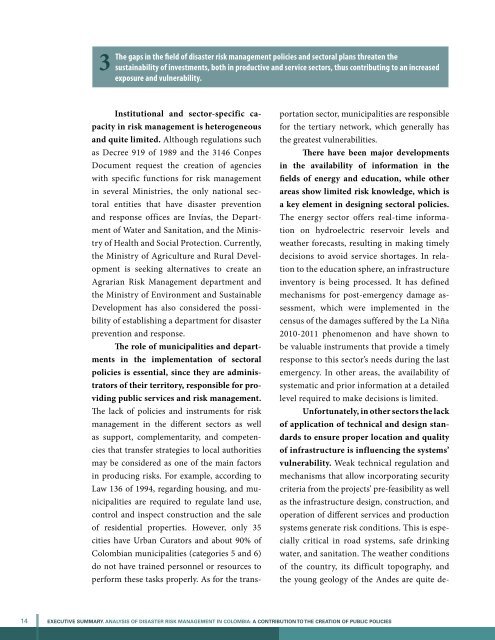Executive Summary - GFDRR
Executive Summary - GFDRR
Executive Summary - GFDRR
You also want an ePaper? Increase the reach of your titles
YUMPU automatically turns print PDFs into web optimized ePapers that Google loves.
3<br />
The gaps in the field of disaster risk management policies and sectoral plans threaten the<br />
sustainability of investments, both in productive and service sectors, thus contributing to an increased<br />
exposure and vulnerability.<br />
Institutional and sector-specific capacity<br />
in risk management is heterogeneous<br />
and quite limited. Although regulations such<br />
as Decree 919 of 1989 and the 3146 Conpes<br />
Document request the creation of agencies<br />
with specific functions for risk management<br />
in several Ministries, the only national sectoral<br />
entities that have disaster prevention<br />
and response offices are Invías, the Department<br />
of Water and Sanitation, and the Ministry<br />
of Health and Social Protection. Currently,<br />
the Ministry of Agriculture and Rural Development<br />
is seeking alternatives to create an<br />
Agrarian Risk Management department and<br />
the Ministry of Environment and Sustainable<br />
Development has also considered the possibility<br />
of establishing a department for disaster<br />
prevention and response.<br />
The role of municipalities and departments<br />
in the implementation of sectoral<br />
policies is essential, since they are administrators<br />
of their territory, responsible for providing<br />
public services and risk management.<br />
The lack of policies and instruments for risk<br />
management in the different sectors as well<br />
as support, complementarity, and competencies<br />
that transfer strategies to local authorities<br />
may be considered as one of the main factors<br />
in producing risks. For example, according to<br />
Law 136 of 1994, regarding housing, and municipalities<br />
are required to regulate land use,<br />
control and inspect construction and the sale<br />
of residential properties. However, only 35<br />
cities have Urban Curators and about 90% of<br />
Colombian municipalities (categories 5 and 6)<br />
do not have trained personnel or resources to<br />
perform these tasks properly. As for the transportation<br />
sector, municipalities are responsible<br />
for the tertiary network, which generally has<br />
the greatest vulnerabilities.<br />
There have been major developments<br />
in the availability of information in the<br />
fields of energy and education, while other<br />
areas show limited risk knowledge, which is<br />
a key element in designing sectoral policies.<br />
The energy sector offers real-time information<br />
on hydroelectric reservoir levels and<br />
weather forecasts, resulting in making timely<br />
decisions to avoid service shortages. In relation<br />
to the education sphere, an infrastructure<br />
inventory is being processed. It has defined<br />
mechanisms for post-emergency damage assessment,<br />
which were implemented in the<br />
census of the damages suffered by the La Niña<br />
2010-2011 phenomenon and have shown to<br />
be valuable instruments that provide a timely<br />
response to this sector’s needs during the last<br />
emergency. In other areas, the availability of<br />
systematic and prior information at a detailed<br />
level required to make decisions is limited.<br />
Unfortunately, in other sectors the lack<br />
of application of technical and design standards<br />
to ensure proper location and quality<br />
of infrastructure is influencing the systems’<br />
vulnerability. Weak technical regulation and<br />
mechanisms that allow incorporating security<br />
criteria from the projects’ pre-feasibility as well<br />
as the infrastructure design, construction, and<br />
operation of different services and production<br />
systems generate risk conditions. This is especially<br />
critical in road systems, safe drinking<br />
water, and sanitation. The weather conditions<br />
of the country, its difficult topography, and<br />
the young geology of the Andes are quite de-<br />
14 EXECUTIVE SUMMARY. ANALYSIS OF DISASTER RISK MANAGEMENT IN COLOMBIA: A contribution TO the creation of public policies

















